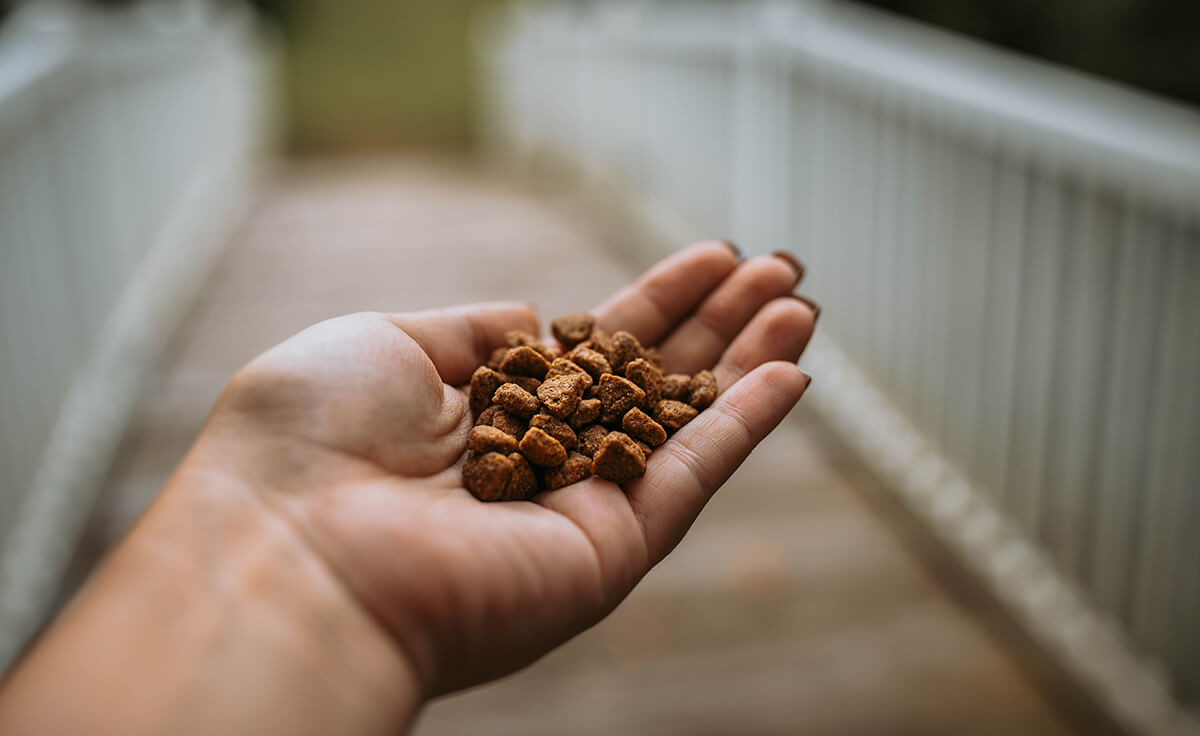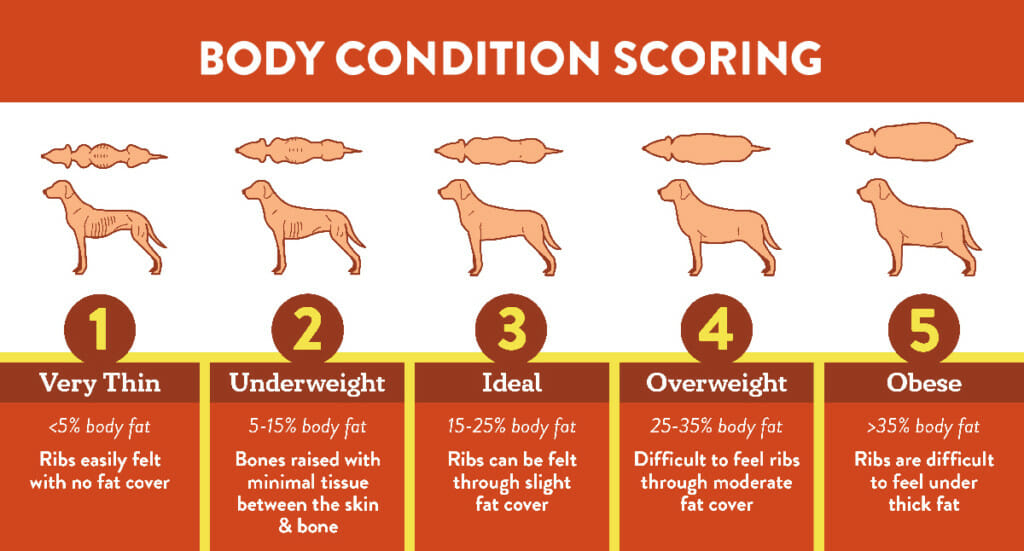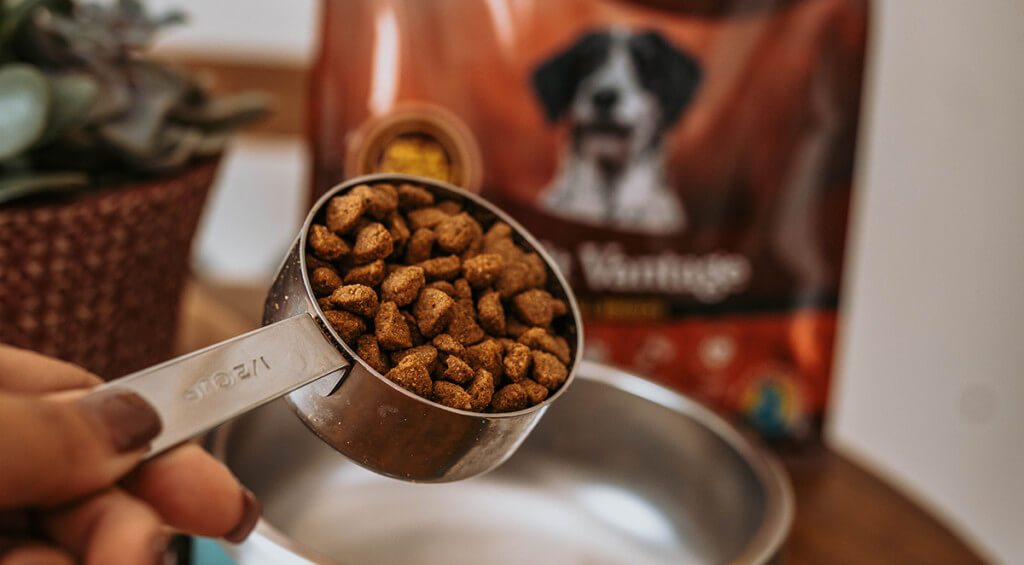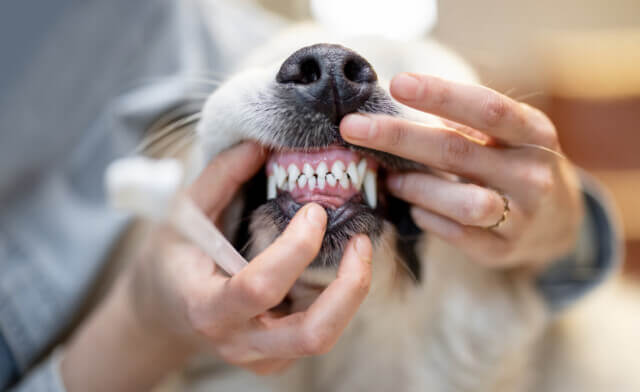Is My Dog Overweight?
Believe it or not, it may not be super obvious if your dog is overweight. However, knowing what signs to look for are crucial when it comes to making sure your dog lives a long, healthy life. Learning about what makes a dog overweight and health issues to keep an eye out for if you have determined your dog is in fact carrying a few extra pounds are super important factors when it comes to keeping up with your dog’s health. While a few extra pounds may not seem like a huge deal, the health concerns that come with a few extra treats can actually take years off of your dog’s life if they’re not diagnosed and addressed properly.

How Do I Know if My Dog is Overweight?
“Is my dog overweight?” “Is my puppy fat?” “Is my dog obese?” When it comes to how to tell if your dog is overweight, there are a few ways to get an idea if a vet visit is in order.
The Association for Pet Obesity Prevention details the following guidelines to help get an idea if your pet is overweight:
“First, you should be able to easily feel – and count – your dog’s ribs when you lightly run your fingers across the side.
“Next, when you look down on your pet from above, you should see an hourglass figure or an indentation near the midsection. If your pet looks like a blimp from above, it’s probably overweight or has obesity.
“Finally, when you observe your pet from the side as it stands, you should see a slight tuck or upward slope of the tummy. If the abdomen hangs low and drags near the ground (a condition in cats Dr. Ward calls “Swiffer cats”), that indicates the most dangerous and biologically active form of fat, abdominal fat, is present.
Other signs your dog is overweight include a range of more obvious symptoms like physical appearance to less obvious signs like snoring. One thing that you should keep in mind is that if your dog is overweight it could put extra stress on their joints. This is why a diet with glucosamine and chondroitin sulfate are super important for overweight dogs, but if you notice your dog is having a harder time getting around (for example, it’s taking a few extra tries to get onto the couch) it could be a sign that extra weight is putting stress on their joints.
Snoring is a sign that not many people think of when it comes to your dog putting on a few extra pounds, but those extra pounds can lead to impaired respiratory function. Newly developed snoring or difficulty breathing after your daily walk could be chalked up to the fact that your dog may be overweight, so if you notice these symptoms be sure to check with your vet to rule out other health issues and set up a weight loss plan if needed.
If you do have an overweight dog, don’t fear! Scheduling a visit with your vet can help you come up with a manageable plan for your dog’s diet and exercise to get your dog back on track.
Dog Weight Chart
One way to tell if your dog is maybe overweight is by looking at a Body Condition Score chart. A Body Condition Score (BCS) is a rating that is typically on a scale of 1-5, with 1 being too thin, 5 being obese, and 3 being the idea score that your dog should be at. Some versions also use a rating of 1-9. You can think of a dog’s BCS kind of like a dog BMI.
PetMD recommends the following method to help you decide which area on the chart your dog lands:
“To begin, gently press your hands over the rib cage. Individual ribs should be evident without having to press hard, but they should not be readily felt. There should be no overlying fat, and they should not be seen readily.
“There should be a nice, seemingly proportionate “abdominal tuck” or “hourglass” when palpating your dog’s waist from the side or along his back. Physically palpating is particularly important in dogs with excess fur. Dogs that are too thin will have bony prominences, particularly over the hip bones, shoulder blades and ribs. Dogs who are obese will have excessive soft or fatty areas that are evident, and it will be more difficult or impossible to feel their ribs or hip bones.”

So while there’s not a dog weight chart per say, the BCS chart is a way to tell about how much body fat your dog should have. That being said, while a BCS chart can be a great starting point when trying to determine if your dog needs a weight loss plan, this is something that needs to be confirmed and talked about with your vet. Ideal dog weight changes based on a variety of factors and while a dog weight chart by breed may seem helpful, a range of other conditions can influence what is considered a healthy weight for your dog specifically.
Why Dogs Become Overweight
For a dog gaining weight, it can sometimes be hard to tell exactly why–especially if your routine hasn’t changed. Weight gain in dogs can happen for a variety of reasons ranging from overeating to health issues.
Overeating is the top cause of canine obesity, largely because most pet owners aren’t aware of how many calories their pet should be eating per day. All pet food labels have feeding guidelines and too often pet owners look at the feeding guidelines and feed exactly that amount.
However, exactly how much your dog should eat per day is a conversation you need to have with your vet. Your vet will take into account a variety of other factors like your lifestyle, your dog’s exercise, any health issues, and more to determine a healthy amount to feed. Feeding guidelines are a great resource, but are meant to serve as a starting point, not the final say.
Which Dogs Are Prone to Obesity?
There are several factors that can make a dog more prone to obesity such as age, breed, health issues, and whether or not they’re spayed or neutered.
Age is a large factor. Just like humans, as dogs get older their metabolisms tend to slow down. Pair that with decreased activity and potential over-feeding and your dog will be putting on extra weight in no time. As your dog gets older, it’s important to continue checking in with your vet to make sure you’re feeding a number of calories that your dog’s metabolism can keep up with.
Health issues are another factor. Health issues that cause your dog to become inactive, increase their appetite, or both make your dog more prone to weight gain and obesity.
Health Effects of Being Overweight
If you’ve determined that your dog is overweight, it’s best to have your vet check for potentially underlying issues that are caused by weight gain. While health issues can lead to weight gain, weight gain can also lead to health issues so it’s best to cover all your bases with your vet.
If you have an obese dog, breathing problems and joint problems are a main concern. That being said, for an overweight dog problems with other health complications that stem from being overweight can also happen. For example Pet Health Network explains that, “Weight gain can cause heart disease and high blood pressure. It’s also linked to breathing problems. Overweight dogs are more prone to a collapsing trachea and laryngeal paralysis. Untreated, these airway conditions could lead to a respiratory crisis which could be fatal if not treated.”
Joint problems in dogs is a large concern when it comes to them gaining weight. As mentioned earlier, added stress on their joints caused by extra weight can lead to other mobility issues, which is why a weight management dog food that includes glucosamine and chondroitin sulfate is super important. Obesity paired with a decline in joint health can also lead to Osteoarthritis, a main cause of back problems in dogs as well.
My Dog is Overweight but Doesn’t Eat Much
If your dog is overweight but not eating much, you may want to schedule a vet appointment to have your dog checked for health conditions, including hypothyroidism. Hypothyroidism is when the thyroid, what regulates the body’s metabolic rate, is underactive and therefore slows the metabolism. If your dog isn’t eating much but is still gaining weight, it could be because their thyroid isn’t active enough to metabolize the food they’re eating.
According to VCA Hospitals, here are the two major causes of hypothyroidism, which they say account for more than 95% of cases:
“In dogs, hypothyroidism is usually caused by one of two diseases: lymphocytic thyroiditis or idiopathic thyroid gland atrophy. The former disease is the most common cause of hypothyroidism and is thought to be an immune-mediated disease. This means that the immune system decides that the thyroid is abnormal or foreign and attacks it. It is unclear why this occurs; however, it is a heritable trait meaning that genetics plays a role in this condition. In idiopathic thyroid gland atrophy, normal thyroid tissue is replaced by fat tissue. This condition is also poorly understood.”
VCA Hospitals also provides a great list of dog hypothyroidism symptoms:
- Weight gain without an increase in appetite
- Lethargy and lack of desire to exercise
- Cold intolerance (gets cold easily)
- Dry, dull hair with excessive shedding
- Very thin to nearly bald hair coat
- Increased dark pigmentation in the skin
- Increased susceptibility and occurrence of skin and ear infections
- Failure to regrow hair after clipping or shaving
- High blood cholesterol
- Slow heart rate
While hypothyroidism can’t be cured, it can be treated with medication from your vet so check with them to find out your options.

What is Cushing’s Disease in Dogs?
In addition to hypothyroidism, dog obesity can also lead to Cushing’s Disease, another health problem to look out for if your dog is gaining weight but not eating more than usual. Cushing’s Disease happens when your dog’s body produces too much cortisol, a hormone stored in the adrenal glands. Ann Stohlman, V.M.D and a veterinarian in FDA’s Center for Veterinary Medicine, says “Cortisol is one of the body’s natural steroids,” and adds that a normal amount of cortisol helps the body adapt in times of stress. Cortisol also helps regulate proper body weight, tissue structure, skin condition, and other features of good health.
There are two types of Cushing’s Disease:
- The first, more common type happens when a tumor develops on the pituitary gland at the base of the brain, causing an overproduction of hormones that stimulate an excess production of cortisol.
- The second happens when a tumor in an adrenal gland causes excess cortisol and is less common.
The treatments for each type are different, so blood tests or ultrasounds are used to determine which type of Cushing’s Disease is present and also to determine treatment.
While Cushing’s Disease is most common in middle-age or senior dogs, it’s important to know what symptoms to look for. According to Chewy, the most common symptoms of Cushing’s Disease in dogs are:
- Increased thirst and urination (polydipsia and polyuria, respectively)
- Increased hunger
- Increased panting
- Pot-bellied abdomen
- Loss of hair
- Recurrent infections of skin, ears, urinary tract, etc.
- Darkening of the skin
- Appearance of blackheads on the skin
- Thin skin
- Bruising
- Hard white scaly patches on the skin or elbows (associated with the disease calcinosis cutis)
- Lack of energy
- Inability to sleep (insomnia)
- Muscle weakness
- Infertility
- Obesity
- Fat pads on the neck and shoulders
- Neurologic abnormalities (circling, behavioral changes, seizures, etc.)
Canine Obesity Statistics
The Association for Pet Obesity Prevention is an organization that researches and spreads awareness about pet obesity levels in the United States. In their 2018 research on pet obesity, they found that an estimated 60% of cats and 56% of dogs in the United States were overweight or obese.
Older dogs are more prone to obesity than younger dogs due to an increase in inactivity as they age. All dogs can be obese, but dogs between the ages of 5 and 12 are more likely to experience obesity according to Dr. Jerry Klein, AKC’s chief veterinary officer. As your dog gets older, it’s important to consider daily calories and exercise and make sure there’s a healthy balance, as overweight dogs’ life expectancy is on average about 2.5 years shorter than that of a dog at a healthy weight.
The Association for Pet Obesity Prevention also polled pet owners and veterinarians about their weight loss methods and their effectiveness:
“Pet owners and veterinary professionals were questioned about pet obesity, diet and nutrition, and pet weight loss. 80% of veterinary professionals reported they had tried to help their pet lose weight, along with 68% of pet owners. The leading pet weight loss method was ‘calorie reduction/smaller portions’ favored by 68% of all respondents. 61% increased exercise, 29% tried a low-calorie or low-fat pet food, and 19% fed a therapeutic or ‘prescription’ diet from their veterinarian.
“When all respondents were asked what weight loss method was most effective, 38% rated calorie reduction/smaller portions as ‘very effective’ and 33% ranked it as ‘somewhat effective.’ 36% reported increased exercise as ‘very effective’ along with 30% reporting it was ‘somewhat effective.’ Only 9% reported low-calorie or low-fat diets as ‘very effective’ while 23% reported it was ‘somewhat effective.’ ‘Prescription weight loss diets’ were given a 13% ‘very effective’ rating and 14% ‘somewhat effective.’ Further analysis of ‘prescription diet’ revealed 50% of veterinary professionals and 70% of pet owners reported they ‘never tried’ this weight loss method and 27% of veterinary professionals and 9% of pet owners ranked it as ‘very effective.’”

Breeds Prone to Obesity
Pugs
Pugs are a breed prone to obesity because of their short noses. Short noses like those of pugs have small nasal openings, which makes it difficult for them to get a lot of air to their lungs during strenuous activities. Because of this, pugs tend to get less exercise. Combine less exercise with potential overfeeding and your pug could put on extra weight quickly.
Bulldogs
Bulldogs have a similar situation to pugs–they have short noses and are prone to obesity because they don’t typically get enough exercise. Similar to pugs, portion control is essential if you have a bulldog to avoid weight gain.
Dachshunds
Dachshunds are another breed prone to obesity, but not for the same reason as pugs and bulldogs. Dachshunds were originally bred to be hunters with high energy levels. Now though, most Dachshunds aren’t super active and make great lapdogs. Overfeeding is extremely common with Dachshunds and they require a lot of portion control to avoid obesity.
Beagles
Contrary to what you might think, beagles actually have slower metabolisms than most breeds. While the beagle is a fairly active breed, the majority of beagles don’t get the proper amount of exercise needed to combat their slow metabolisms which can lead to your dog being overweight or obese.
Basset Hounds
Basset Hounds are known to be fairly inactive dogs, and while there’s nothing wrong with this, it does mean that their owners should be paying extra close attention to their portions at meal time. How much you feed your dog when they aren’t typically active plays a huge role in weight gain.
Golden Retrievers
Golden Retrievers are another breed more prone to obesity. They naturally have larger appetites and if they don’t get enough exercise they’re likely to pack on the pounds quickly. The good news is goldens are great active dogs, so balancing their calorie intake with physical activity is relatively easy with a good weight loss plan.
Spayed or Neutered Dogs
According to AKC, “Dogs that have been spayed or neutered also may have a greater tendency to gain weight, possibly due to the change in metabolism and loss of hormones. It’s important for dog owners to be aware of this possibility and make certain their dogs maintain a healthy weight after surgery.”
Weight Loss Dog Food for Overweight Pups?
While proper exercise like walking your dog on a daily basis is super important when it comes to helping your dog lose weight, it’s only a piece of the puzzle. Getting your dog on a consistent, healthy feeding schedule and feeding a weight control dog food will do wonders in addition to a new exercise regimen. Diet and exercise together is key.
Further, a healthy dog food designed for weight loss will also make a huge difference in your efforts. Our Weight Control recipe is designed specifically for pups needing to lose a few pounds. This low-fat, low-calorie recipe is make with lean turkey protein as the first ingredient and is a high fiber dog food. The fiber in a dog’s diet ensures that the food gets broken down more slowly. This works to keep your dog full longer as well as keep your dog’s blood sugar stable between meals.
Another thing to keep in mind when searching for weight loss dog food is to take a look at the labels in your dog treat stash as well. While if you’re trying to help your dog lose weight you shouldn’t be feeding too many treats in general, low-calorie treats are better for training sessions. Our Oven-Baked Biscuits are low-fat treats that are only 9-10 kcal per treat so in moderation they don’t make or break the number on the scale.
In the end, it’s important to be able to tell if your dog has packed on a few extra pounds, and even more important for you to know what to do in that situation. Canine obesity is a common problem for dogs to have, but it’s also a dangerous one if it gets out of hand. Learning ways to tell if your dog is overweight and also ways to combat that is important when it comes to helping your dog live a long, healthy life.




